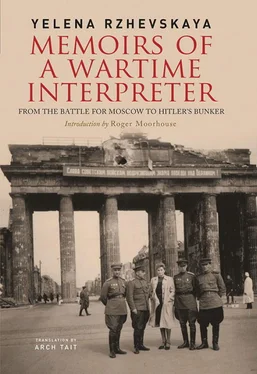There was a firefight in the vestibule with the remnants of the guard, most of whom, however, had fled. Next came the descent. Military and civilian staff began coming out of the corridors, the boxrooms and the rest of the complex with their hands up. The wounded were sitting or lying on the floor. There was groaning. In the underground complex and in the storeys of the Reich Chancellery shooting broke out repeatedly.
We needed to get our bearings immediately, to locate all the exits and block them, get the lie of the land and start searching. In the very mixed collection of people occupying the complex it was no simple matter to identify those who could be helpful, people who would know more than others about Hitler’s fate and could guide us through the labyrinthine complex. We conducted a first sketchy enquiry.
Down there we found a portly forty-year old, Karl Schneider, one of the Chancellery’s garage mechanics. He testified that on 28 or 29 April, he could not remember which exactly, the telephone operator on duty in Hitler’s secretariat gave him an order to deliver all the petrol he had to the Führer’s bunker. Schneider sent eight cans, each containing twenty litres of petrol. Later the same day, he received a further order from the operator to send firelighters. He had eight and sent them all.
Schneider had not himself seen Hitler and did not know whether he was in Berlin, but on 1 May he was told by the head of the garage and by Hitler’s chauffeur, Erich Kempka, that the Führer was dead. Rumours were circulating among the security soldiers that he had committed suicide and that his body had been burnt. Putting these rumours together with the orders he had received, Schneider concluded that the petrol he had sent had been used to burn the Führer’s body.
Then, on the evening of 1 May, he had another call from the duty telephonist, again demanding that all available petrol should be sent to the Führer’s bunker. Schneider siphoned petrol from the fuel tanks of the cars and sent another four cans.
What had that call been about? Who had the petrol been meant for this time? Together with Karl Schneider and Wilhelm Lange (a cook), Major Bystrov, Lieutenant Colonel Klimenko [1] Ivan Klimenko was head of the Smersh counterintelligence department of the 79th Infantry Corps, 3rd Shock Army, 1st Byelorussian Front. Vadim J. Birstein, SMERSH: Stalin’s Secret Weapon, London: Biteback, 2013, p. 303.
and Major Khazin went out into the garden. The ground had been churned up by shells, the trees mutilated, and their charred branches were strewn underfoot. The lawns were blackened by fire and soot, and there was broken glass and piles of bricks everywhere. How were they to determine where the bodies had been burned?
They began an inspection of the garden and, three metres from the garden exit of the Führerbunker, found the half-burnt bodies of Goebbels and his wife. So that was what the second supply of petrol had been for. ‘The German found them first,’ Ivan Klimenko wrote to me in a letter dated 9 February 1965, referring to Schneider. If it had been any later, the torrent of Red Army soldiers pouring into the Reich Chancellery would have trampled the bodies to pieces without even noticing what was under their feet.
The sky over Berlin had not yet ceased to glow; the Reich Chancellery was still smoking. It was dark in the underground complex, and with the ventilation not working it was stuffy, dank and gloomy. In those days, down in the Chancellery’s shelter, I had to sort through a vast number of papers and documents by the light of humble oil lamps. There were on-thespot accounts of street fighting in Bormann’s files, reports from the Berlin Nazi Party leadership about the hopelessness of the situation, their lack of ammunition, the demoralized state of the soldiers. There was Bormann’s correspondence, and Hitler’s personal papers.
My priority in searching through these papers was to find anything that would shed some light at least on what had been happening there in the last few days, that would add a brush stroke or give a clue as to how everything had ended.
Here was Bormann sending telegram after telegram to his adjutant, Hummel, in Obersalzberg, all bearing the red stamp ‘Geheim’, Secret! From the nature of his instructions it was clear they were preparing to move Hitler’s headquarters to Berchtesgaden. They had been planning to get out of Berlin.
Here was a folder containing information from their enemy’s sources, radio intercepts from the last days of April: Reuters news agency reports from Allied headquarters, broadcasts from Moscow about combat operations on the fronts, telegrams about events in the rest of the world, from London, Rome, San Francisco, Washington and Zurich. These sources were used at Hitler’s headquarters to gain a sense of what was happening on other sectors of the front, and in Berlin itself, in the last days of April. By this time, direct contact with the troops had been finally lost.
All the papers in the folder were typewritten in huge letters. I had never before come across such a strange font: it was as if you were reading through a magnifying glass. What was that for? Later I learned that Hitler’s secretary, Gertraud Junge, retyped all the papers on a special typewriter. For reasons of image, Hitler did not want to wear spectacles.
Here was a report from a foreign radio station about the execution of Mussolini and his mistress, Clara Petacci. With a blue pencil, Hitler had underlined the words ‘Mussolini’ and ‘hung upside down’. This discovery seemed to me to be significant: the news of Mussolini’s fate made it clear to Hitler that he needed to avoid discovery of his body after his death. That was my conclusion at the time, and I later found it confirmed in the Council of Ministers Archive, in the memoirs of Rattenhuber, and in the conclusions of the Control Commission for Germany (British element) of 1 November 1945. We searched for documents and, having familiarized myself with them, I annotated them. They were then forwarded, as already mentioned, to front headquarters, as were our own papers, interrogation reports and all other documentation.
Goebbels’ Diary
One of our major finds at the time was Goebbels’ diary. It was found in the underground complex where Goebbels lived with his family, in one of two suitcases of documents. There were ten or so thick notebooks from different years, covered in closely written, heavy handwriting in straight lines. The letters had a barely noticeable slant to the left and were tightly squeezed together. The first books of the diary dated from 1932, before the Nazis came to power, and the last ended on 8 July 1941. We discovered later that this was only the date on which the handwritten diary ends. From the following day, 9 July 1941, and almost to the end, he dictated his entries each day to two shorthand typists.
I greatly regretted not being able to sit down and study this diary, which it was not easy to decipher. It would have needed many days of diligent work, and we were having to count the minutes. Our immediate task was to establish what had happened to Hitler and where we could find him. I had no option but to forward the diaries to front headquarters. With the war at an end, such documents were of purely historical interest and considered to be of no value. They suffered a major devaluation.
In the years that followed, when I recalled Goebbels’ diary I feared the notebooks had been lost along with a host of other documents, but a time came when I had the opportunity to read very carefully a part of this diary, to whose discovery I had contributed and which had been preserved in the archive. It was the last handwritten notebook dating from May, June and early July 1941. Realizing that this diary was a tremendously valuable historical document, I quoted abundantly from it in my book (translated, naturally, into Russian). I thus presided over the first publication from this body of handwritten diaries, revealing their whereabouts to the world. Nobody, of course, had any intention of making the original of the diary available for a foreign edition, and accordingly this chapter is all but missing in the [East] German edition of my book that was edited in the USSR. [1] Jelena Rshewskaja, Hitlers Ende ohne Mythos, tr. Werner Hantke, Berlin: Deutscher Militärverlag, 1967.
Читать дальше











